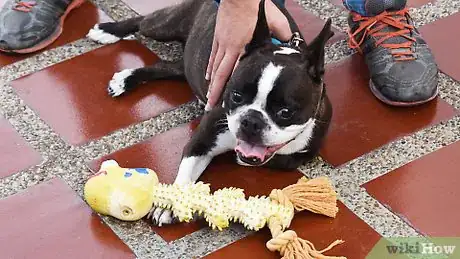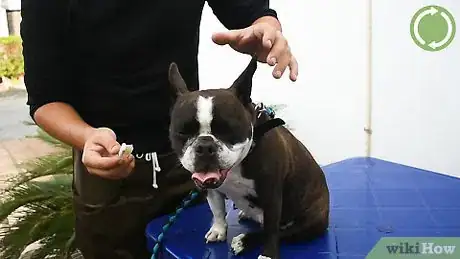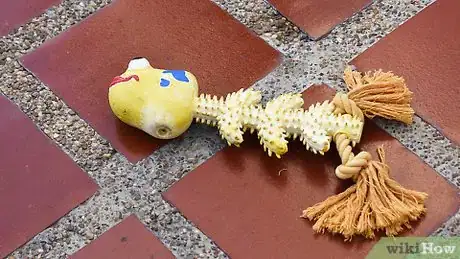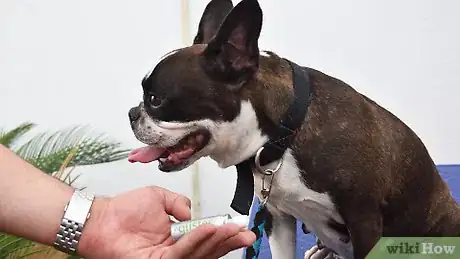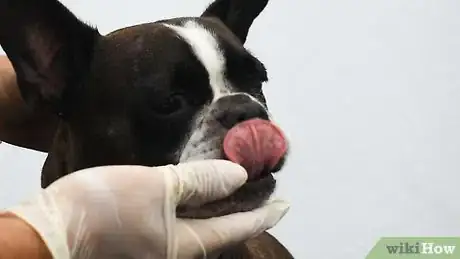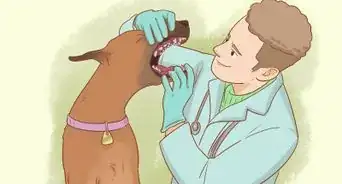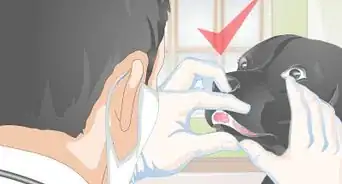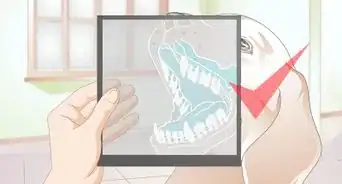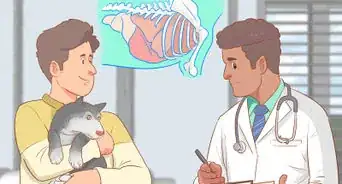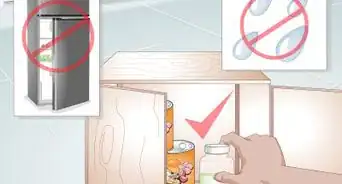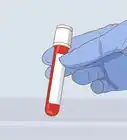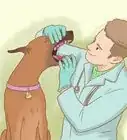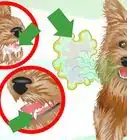This article was co-authored by Cameron Thompsen. Cameron Thompsen is a Dog Trainer and Human Coach, as well as the Owner and Founder of Hope2K9 Foundation. With nearly two decades of experience, she specializes in working with dogs and their owners on behavior issues ranging from severe anxiety, reactivity, as well as aggression and fear-based problems. She works with all dogs at Hope2K9 so that they are fully trained before adoption, and provides lifelong support to dog owners after adoption.
There are 9 references cited in this article, which can be found at the bottom of the page.
wikiHow marks an article as reader-approved once it receives enough positive feedback. This article has 14 testimonials from our readers, earning it our reader-approved status.
This article has been viewed 334,588 times.
Brushing your dog's teeth is an important part of overall care. Keeping your dog's breath fresh is just one good reason to brush regularly. Clean teeth can also boost the health, happiness, and longevity of your canine friend. Plaque and tartar don't just cause bad breath. They can also result in the loss of teeth. Serious dental hygiene issues can also lead to life-threatening and painful infections. These infections can damage the kidneys, heart, and liver. By regularly brushing your dog's teeth, you will help to improve its quality of life and yours.
Steps
Getting Ready to Brush
-
1Get a dog toothbrush. There are a wide variety of toothbrushes to choose from that are designed for dogs.[1] They are available at any pet store.[2]
- Dog brushes have softer bristles and are designed to give you easier access to those hard to reach areas.[3]
- Choose a brush based on the size of your dog. You can use a bigger toothbrush for bigger dogs, but a smaller dogs will need a brush that will easily fit into its mouth.
- There are also finger brushes that fit onto the end of your finger and can provide better precision. But, these brushes also increase the likelihood of your dog accidentally biting your finger.
- Do not use an adult human toothbrush to brush your dog's teeth. You can use a soft child’s toothbrush if necessary.
- Other options to try if your dog resists the brush include specially designed pads and sponges.[4]
-
2Pick out a dog toothpaste. Like brushes, there are many different toothpastes made for dogs. Do not ever use human toothpaste to brush your dog's teeth.[5]
- Human toothpaste contains fluoride and sometimes other ingredients that can be toxic. We don't swallow toothpaste when we brush, but many dogs do. Eating human toothpaste can cause vomiting and possible kidney damage.[6]
- Dog toothpaste is available in many different flavors to help make brushing easier and more pleasant for your dog.
- You may have to try several flavors to find the one that works best for you and your dog.[7]
Advertisement -
3Start when your dog is young. The ideal time to start brushing a dog’s teeth is when it is a puppy.[8] You can start as early as eight weeks of age.
- Starting young can help a dog become accustomed to the feel of the brush and the act of brushing.[9]
- It will not, however, make much difference in the overall cleanliness of a dog's teeth. This is because it will not have all its permanent teeth until it is six to seven months old.
-
4Choose a good time for brushing. When you brush your dog's teeth can have a big impact on how successful you are. Try to brush the dog's teeth when it is calm and relaxed.[10]
- A good time to try this is after the dog has been exercising or playing. It will hopefully be tired and less likely to struggle with you.
Brushing The Dog's Teeth
-
1Get your dog comfortable with your hand in its mouth. When first starting to brush your dog's teeth, take it slow to gradually get the animal used to your hands in and around its mouth.[11] Frequently touch around the dog's mouth and muzzle with your fingers.[12]
- It may take time for it to get used to you touching this area.
-
2Let the dog lick some toothpaste off your finger. Start the process by letting the dog lick a small amount of toothpaste off of your finger. This will help you determine how well it likes the toothpaste. It will also help the dog to get used to the taste, making it more likely accept the toothpaste when it is on the toothbrush.[13]
- After the dog licks the toothpaste, rub your finger along the teeth and gums while lifting the lips. This is the same motion that you will use when brushing and will help with transitioning to using a brush.[14]
-
3Show the toothbrush to your dog. Next, show the toothbrush to your dog and let it inspect the brush before putting it in its mouth.
- You can also let the dog lick some toothpaste off the brush. Praise the dog for this behavior. This will help the dog become accustomed to the brush being around its mouth.[15]
-
4Brush a few teeth. With or without using toothpaste, gently brush one or a few of the easiest to reach teeth. The canine teeth are the longest and usually the easiest to to reach.[16]
- Gently lift the upper lip and place the toothbrush onto the teeth. Then, slowly brush back and forth.
- This will help your dog get used to the new feeling of the brush on their teeth and gums, and also lets you see how they respond.
- Some dogs will be receptive to brushing, but if your dog is reluctant or acting aggressive, proceed cautiously. Ideally, try it while a friend or family member can pet and help to calm the dog.
- Using a calm and soothing voice can also help to keep your dog calm. If your dog continues to resist or to be aggressive, try giving it a break and trying again later or another day. If this behavior continues, consult with your veterinarian or dog trainer for advice on what to try next.
- After brushing just a few teeth, reward the dog with a treat and end the session.[17]
-
5Brush the outsides of the dog's teeth. Once your dog is used to the taste of the toothpaste and the feel of the toothbrush, it is time to combine the two. Place a small amount of toothpaste on the toothbrush and slowly and gently start to brush in the same area as before. Then, gradually move along the entire outside surface of all the upper and lower teeth.[18]
- Increase the number of teeth you brush each time until the dog is comfortable having all of them brushed.[19]
- Try to brush along the entire gum line. This allows you to get them used to the act of brushing without having to try to open the dog's mouth.[20]
- Limit the brushing sessions to just a few minutes each. It may take a few sessions to get your dog used to the process.
- Throughout the process, praise the dog in a calm voice while brushing.[21]
-
6Brush the inside surfaces. Once you are able to brush the outsides of all the teeth in one session, you are ready to try brushing along the inside surfaces.[22]
- Put one hand over the top of the muzzle, lifting the upper lips, and open the dog's mouth. If the dog is reluctant to open, applying gentle inward pressure can help to get it to open its mouth.
- Once the mouth is open, brush a small area of the inside teeth surfaces. As always, go slowly, brushing small areas to start. Move on to larger areas as the dog becomes more accustomed to brushing.[23]
- Your dog's tongue naturally helps to control tartar build up along the inside surfaces. Brushing there will make a big difference though.
-
7Make it a routine. The more often you brush your dog's teeth, the more it will get accustomed to your hands in and around its mouth. This will make brushing easier over time.[24]
- Brushing your dog's teeth every day is ideal. It will help to prevent periodontal disease that can lead to pain and dangerous infections.[25]
- If your dog has loose teeth, seems sensitive around its mouth, or is bleeding orally, consult a veterinarian before you continue brushing.[26]
- Start slowly and try to work up to daily brushing. If you are unable to brush every day, try to brush as often as possible.
Cleaning the Teeth of an Uncooperative Dog
-
1Use a cloth. Using a toothbrush and toothpaste is ideal. But, if your dog will not tolerate brushing, there are other options available. If your dog will not tolerate a toothbrush, try applying toothpaste with a thin piece of material.
- You can use an old pair of stockings, a worn washcloth, or a piece of gauze wrapped around your finger.[27]
- Using this method to "brush" will create some friction while applying the paste and help to slow plaque build-up.
-
2Use chew toys. Chew toys can help wipe away soft tartar and massage the gums. They also prevent boredom and reduce stress.[28]
- Give your dog rawhide, nylon, and rubber chew toys. Ask your veterinarian for a recommendation.
- Giving your dog chew toys and bones is a good supplement to regular brushing. They are not a good replacement for brushing in the long term.
-
3Pick a food that helps clean teeth. Feeding dry dog food and treats rather than canned food will help to slow the build-up of plaque and tartar.[29]
- There are also special foods designed to aid in cleaning teeth as a dog eats, but these are not meant to replace brushing.
-
4Try a gel or spray. Other alternatives to brushing include sprays and gels that you can apply regularly. They contain ingredients that help to deter the bacterial growth that causes tartar build-up.[30]
- Consult with your veterinarian about using these and other products.
-
5Get a professional cleaning. If your dog will not accept you cleaning its teeth, bring it to the vet and have it done for you.
- Also be sure to discuss your dog's dental health at your regular vet visits.[31]
Expert Q&A
Did you know you can get expert answers for this article?
Unlock expert answers by supporting wikiHow
-
QuestionHow do you brush a dog's teeth that hates being brushed?
 Cameron ThompsenCameron Thompsen is a Dog Trainer and Human Coach, as well as the Owner and Founder of Hope2K9 Foundation. With nearly two decades of experience, she specializes in working with dogs and their owners on behavior issues ranging from severe anxiety, reactivity, as well as aggression and fear-based problems. She works with all dogs at Hope2K9 so that they are fully trained before adoption, and provides lifelong support to dog owners after adoption.
Cameron ThompsenCameron Thompsen is a Dog Trainer and Human Coach, as well as the Owner and Founder of Hope2K9 Foundation. With nearly two decades of experience, she specializes in working with dogs and their owners on behavior issues ranging from severe anxiety, reactivity, as well as aggression and fear-based problems. She works with all dogs at Hope2K9 so that they are fully trained before adoption, and provides lifelong support to dog owners after adoption.
Dog Trainer
-
QuestionMy dog's tartar builds up quickly, what can I do to get rid of the deposits?
 Pippa Elliott, MRCVSDr. Elliott, BVMS, MRCVS is a veterinarian with over 30 years of experience in veterinary surgery and companion animal practice. She graduated from the University of Glasgow in 1987 with a degree in veterinary medicine and surgery. She has worked at the same animal clinic in her hometown for over 20 years.
Pippa Elliott, MRCVSDr. Elliott, BVMS, MRCVS is a veterinarian with over 30 years of experience in veterinary surgery and companion animal practice. She graduated from the University of Glasgow in 1987 with a degree in veterinary medicine and surgery. She has worked at the same animal clinic in her hometown for over 20 years.
Veterinarian Some of the top end vet recommended toothpastes have a limited action at removing tartar. The most likely way of shifting mild tartar deposits is to feed a prescription diet designed to aid dental health, such as Hills TD. If you feed this exclusively for 1 month and then check again, you should find some improvement. Unfortunately, for heavy tartar deposits a professional descale may be your only option.
Some of the top end vet recommended toothpastes have a limited action at removing tartar. The most likely way of shifting mild tartar deposits is to feed a prescription diet designed to aid dental health, such as Hills TD. If you feed this exclusively for 1 month and then check again, you should find some improvement. Unfortunately, for heavy tartar deposits a professional descale may be your only option.
Warnings
- If you see that your dog needs further help with its teeth, consult your vet.⧼thumbs_response⧽
- If a dog's teeth are not taken care of, there can be many negative health consequences beyond oral hygiene. Good mouth care means a longer, happier life for your best friend.⧼thumbs_response⧽
- Do not try to overpower or force your dog if it resists brushing. If your dog shows signs of fear or aggression during this process, stop immediately. You may need to consult a behaviorist to remedy this problem.[34]⧼thumbs_response⧽
References
- ↑ Cameron Thompsen. Dog Trainer. Expert Interview. 31 March 2022.
- ↑ https://www.aspca.org/pet-care/virtual-pet-behaviorist/dog-behavior/brushing-your-dogs-teeth
- ↑ http://www.peteducation.com/article.cfm?c=2+2089&aid=384
- ↑ http://www.peteducation.com/article.cfm?c=2+2089&aid=384
- ↑ http://www.peteducation.com/article.cfm?c=2+2089&aid=384
- ↑ http://www.peteducation.com/article.cfm?c=2+2089&aid=384
- ↑ https://www.aspca.org/pet-care/virtual-pet-behaviorist/dog-behavior/brushing-your-dogs-teeth
- ↑ https://www.aspca.org/pet-care/virtual-pet-behaviorist/dog-behavior/brushing-your-dogs-teeth
- ↑ Cameron Thompsen. Dog Trainer. Expert Interview. 31 March 2022.
- ↑ http://pets.webmd.com/healthy-dog-teeth-10/slideshow-brushing-dog-teeth
- ↑ Cameron Thompsen. Dog Trainer. Expert Interview. 31 March 2022.
- ↑ https://www.aspca.org/pet-care/virtual-pet-behaviorist/dog-behavior/brushing-your-dogs-teeth
- ↑ http://www.peteducation.com/article.cfm?c=2+2089&aid=384
- ↑ http://www.peteducation.com/article.cfm?c=2+2089&aid=384
- ↑ http://www.peteducation.com/article.cfm?c=2+2089&aid=384
- ↑ http://www.peteducation.com/article.cfm?c=2+2089&aid=384
- ↑ http://www.peteducation.com/article.cfm?c=2+2089&aid=384
- ↑ https://www.aspca.org/pet-care/virtual-pet-behaviorist/dog-behavior/brushing-your-dogs-teeth
- ↑ https://www.aspca.org/pet-care/virtual-pet-behaviorist/dog-behavior/brushing-your-dogs-teeth
- ↑ https://www.aspca.org/pet-care/virtual-pet-behaviorist/dog-behavior/brushing-your-dogs-teeth
- ↑ http://www.peteducation.com/article.cfm?c=2+2089&aid=384
- ↑ https://www.aspca.org/pet-care/virtual-pet-behaviorist/dog-behavior/brushing-your-dogs-teeth
- ↑ https://www.aspca.org/pet-care/virtual-pet-behaviorist/dog-behavior/brushing-your-dogs-teeth
- ↑ https://www.aspca.org/pet-care/virtual-pet-behaviorist/dog-behavior/brushing-your-dogs-teeth
- ↑ https://www.aspca.org/pet-care/virtual-pet-behaviorist/dog-behavior/brushing-your-dogs-teeth
- ↑ https://www.aspca.org/pet-care/virtual-pet-behaviorist/dog-behavior/brushing-your-dogs-teeth
- ↑ http://www.vcahospitals.com/main/dog-care/article/brushing-your-dogs-teeth
- ↑ http://www.aspca.org/pet-care/dog-care/ten-steps-your-dogs-dental-health
- ↑ http://www.dogfoodadvisor.com/choosing-dog-food/dry-dog-food-cleaner-teeth/
- ↑ http://www.peteducation.com/article.cfm?c=2+2089&aid=384
- ↑ http://www.peteducation.com/article.cfm?c=2+2089&aid=384
- ↑ http://www.peteducation.com/article.cfm?c=2+2089&aid=384
- ↑ https://www.aspca.org/pet-care/virtual-pet-behaviorist/dog-behavior/brushing-your-dogs-teeth
- ↑ https://www.aspca.org/pet-care/virtual-pet-behaviorist/dog-behavior/brushing-your-dogs-teeth
About This Article
Before you brush your dog’s teeth, touch frequently around its mouth and muzzle so it will be comfortable with your hands being in that area. Place a small amount of doggy toothpaste on your finger and let the dog lick it off to get used to the taste. Let the dog inspect the brush, then brush the dog’s teeth on the outside once it seems relaxed. Eventually, the dog should be comfortable enough to allow you to brush the insides of the teeth, although it may take several sessions to get to this point. To learn more from out Veterinarian co-author, such as what to do with an uncooperative dog, keep reading!




